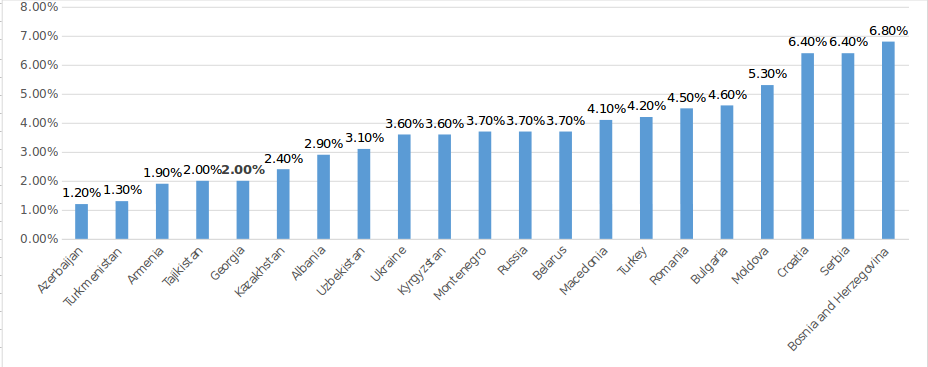The Minister of Labour, Health and Social Affairs of Georgia, Davit Sergeenko, spoke about state funding for healthcare on air on Imedi TV. The Minister stated: “Georgia spends 2.5% of the country’s gross domestic product for healthcare. In Europe, this is 5%-7% or 10% on average. The United States spends 17% of its gross domestic product for healthcare.”
We took interest in the accuracy of the Minister’s statement.
There are several international indices which show the amount of money necessary to make for an efficient healthcare system. One of the principal indicators is the budget expenses for healthcare to GDP ratio. As recommended by the World Health Organization, state expenditures for healthcare should be 5% of a country’s GDP.
FactCheck analysed the fulfilment figures for consolidated budget and state budget expenditures. State funding for healthcare from the 2016 consolidated budget was GEL 1.46 billion which constituted 10% of the total state expenses. As of 2016 data, Georgia’s GDP was GEL 33.921 million. Therefore, state expenses for healthcare amounted to 3% of the country’s GDP. According to state budget statistics, GEL 982 million was spent for healthcare in 2016 which was 10% of total state expenses and 2.9% of the GDP.
Statistics for last year demonstrate that state expenses for healthcare have been growing annually (Table 1). Despite this trend, state healthcare funding is far below as compared to the World Health Organization’s declared minimum.
Table 1: State Expenses for Healthcare
|
2013 |
2014 |
2015 |
2016 |
|
|
State Budget Healthcare Expenses to GDP Ratio (%) |
1.8% |
2.2% |
2.7% |
2.9% |
|
Consolidated Budget Healthcare Expenses to GDP Ratio (%) |
1.9% |
2.4% |
2.8% |
3% |
Source: Ministry of Finance, National Statistics Office of Georgia
Whilst speaking about healthcare expenses, Davit Sergeenko compared Georgia’s figures to those of Europe and the United States. According to the latest data of the World Health Organization and the World Bank from 2014, the share of state healthcare expenses in European Union member states is 7.8% of the GDP. State healthcare expenses in Germany, Austria and France are approximately 9% of their GDPs whilst it is 9.5% in the Netherlands and 10% in Sweden.
According to the World Health Organization, the United States spends 8% of its GDP for healthcare. In regard to the 17% as named by the Minister, this figure constitutes total healthcare expenses (state and private expenses taken together). Therefore, Davit Sergeenko compares two different figures to each other. In the case of Georgia and other European countries, he used the state (government) expenses for healthcare to GDP ratio whilst in the case of the United States he compared these expenses to a completely different figure; namely, the total healthcare expenses to GDP ratio. We further clarify that Mr Sergeenko was speaking about state healthcare expenses (that was the exact question of the journalist) and not about total healthcare expenses.
According to the latest data of the World Health Organization from 2014, total healthcare expenses in Georgia constitute 7% of the GDP. State budget expenses for healthcare are 2% of the GDP.
It is appropriate for us to compare Georgia’s figures to those countries with similar levels of economic development as opposed to those of developed countries of Europe or the United States. According to the World Bank’s classification, Georgia belongs to the Europe and Central Asia region which includes other countries with economies similar to ours. According to the World Bank’s latest data (which in turn is based on the World Health Organization’s data), the average healthcare expenses of the Europe and Central Asia region countries constitute 3.8%.
Graph 1: State Healthcare Expenses to GDP Ratio (Europe and Central Asia Region. High Income Countries are Excluded)
Source: World Bank, World Health Organization
According to the World Health Organization’s data for 2014, Georgia is indeed one of the outsiders in terms of the state healthcare expenses to GDP ratio. It is true that this figure increased to 3% after 2014 even though Georgia continues to lag behind the majority of the region’s countries.
Conclusion
As recommended by the World Health Organization, the state healthcare expenses to GDP ratio should be 5% of a country’s GDP. According to 2016 data, Georgia’s state expenditure (from the budget) for healthcare constitutes approximately 3% of the country’s GDP. Of note is that state healthcare funding has been growing over the last years. According to the World Health Organization, this figure was approximately 2% in 2014 although Georgia still remained one of the outsiders in the group of countries comprising the Europe and Central Asia region.
Davit Sergeenko compared Georgia’s figures to those of other European countries and the United States. State healthcare expenditures in European Union member countries is 7.8% on average whilst it is 8% in the United States. The Minister also emphasised that the United States spends 17% of its GDP for healthcare although this figure is the total amount of healthcare expenses (including the private sector) to GDP ratio. Therefore, Mr Sergeenko, whilst speaking state healthcare expenses, compared Georgia’s figure to another totally different indicator.
The context of the Minister’s statement that state healthcare expenses in Georgia are not high and, in fact, are less as compared to other countries is true. However, the figures and the comparison made in his statement are not entirely accurate.
Therefore, Davit Sergeenko’s statement is MOSTLY TRUE.


















